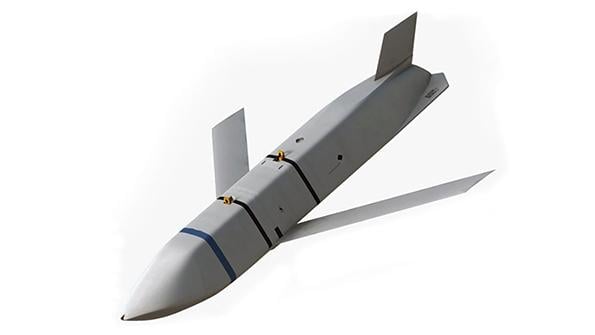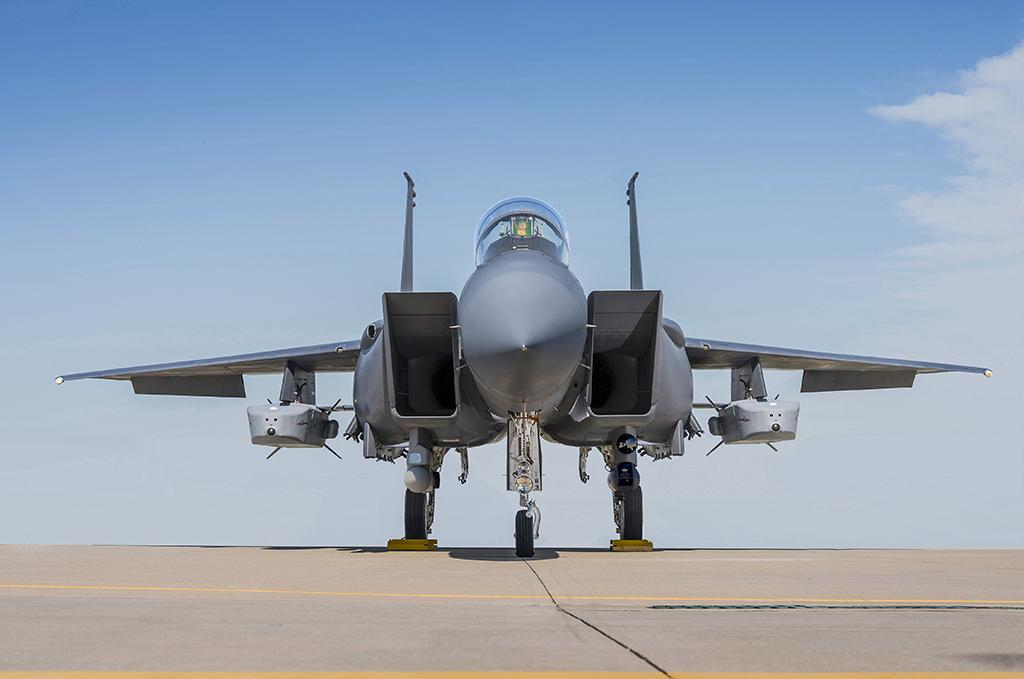
Thirty years ago, news cameras shot shaky imagery of long tubular missiles flying across the Baghdad skyline. They were a mix of Raytheon Tomahawks launched from U.S. Navy warships in the Arabian Sea and Boeing AGM-86 Air Launched Cruise Missiles, released from Boeing B-52s in the final moments of their flights, closing in on targets in the city center with a precision never seen in previous conflicts.
The missile firings were the opening shots of one of the most successful air campaigns in history. Within 39 days the air assault had rendered Iraq’s armed forces ineffective, ruined the country’s economy and helped prevent the conflict from drawing in neighboring states.
- Advanced seekers drive greater autonomy in engagement endgame
- More than 20 countries have air-launched cruise missiles
- Weapons use low-observability tech to increase survivability
Operation Desert Storm almost certainly secured the role of the cruise missile for future air campaigns, with the weapons providing the opening salvos for attacks in Afghanistan, Kosovo, Libya and more recently Syria.
Today, nearly 20 countries have an air-launched cruise missile capability and others are aspiring toward it as the technology proliferates. Nations such as Brazil, India and Pakistan are developing their own.
Increasingly, the missiles no longer are seen as just an offensive capability in the hands of the superpowers, but also as a defensive one—a long arm that can hold adversaries at bay. Neutral Finland has equipped its Boeing F/A-18 Hornets with the Lockheed Martin Joint Air-to-Surface Standoff Missile (JASSM), Sweden is considering the integration of a long-range missile for its Saab Gripens later in the 2020s, and Taiwan has developed an air-launched cruise missile for use from its AIDC F-CK-1 Ching-Kuo indigenous combat aircraft.
“The significantly increased effective range of air-defense and anti-ship missiles since the end of the Cold War has allowed these nominally defensive systems to be used for offensive political purposes in various parts of the world, by threatening air and maritime assets far outside the territory on which they are based,” says Justin Bronk, a fellow for airpower and technology at the London-based Royal United Services Institute. “Cruise missiles are a necessity for any nation or coalition which needs the capability to threaten or destroy targets protected by modern ground-based air-defense networks.”
At the same time, the definition of a cruise missile is being blurred. Loitering munitions and attritable UAVs—including those being developed as additive capabilities for future combat aircraft—use similar technologies, as do air-launched decoys such as Raytheon’s Miniature Air-Launched Decoy and proposed systems from MBDA and Saab. The term “cruise missile” also has been hijacked and associated with shorter-range standoff weapons and even anti-ship missiles, although some have a limited land-attack capability. Even the UK’s new MBDA Spear 3 weapon recently was described by the company as a mini cruise missile.
The cruise missile’s precursors date back more than a century. Curtiss-Sperry’s Aerial Torpedo took a converted biplane, fitted it with remote controls and filled it with explosive, although it was never used in anger.
Then just 25 years later, during World War II, Hitler’s Germany launched thousands of V-1 pulsejet-powered flying bombs against the Allies, including more than 1,000 launched from modified Heinkel He.111 bombers.
Fast-forward to today: Modern cruise missiles are capable of flying thousands of kilometers across land and sea, their positions guaranteed by satellites. Then, in the final moments of an attack, onboard sensors seek out the objectives before the missiles’ penetrating warheads defeat even hardened targets.
Development of a cruise missile will be bound up in the requirements stipulated by the sponsoring nation, but among the most prominent will center on the weapon’s launch platform. This will generate its own constraints including the physical size and weight of the weapon, particularly if it needs to be fitted inside an aircraft’s internal bay-—like that of the Lockheed Martin F-35 Joint Strike Fighter. Platform legacy is another factor, as the weapon might end up being in service longer than the carrier aircraft. For example, carriage of the UK’s MBDA Storm Shadow had to be transferred from the Panavia Tornado to the Eurofighter Typhoon when the Tornado exited service in 2019.
That means consideration also is needed for future platforms. This is a particular issue in cases where missile companies have not had input into aircraft development programs and is being addressed in Europe through initiatives such as the UK-led Tempest and German/French/Spanish Future Combat Air System.
As with all weapons, range has a major influence on design, not only for the amount of fuel carried onboard, but also how close to the target the carrying platform needs to be before launch. A longer-range weapon permits planners to undertake more circuitous routes, reducing exposure to detection. It also can allow for attacks to be conducted from several different directions to overwhelm air defenses, or alternatively, several targets can be struck simultaneously in different parts of a country by multiple weapons to achieve a particular effect.
In addition to fuel, designers also must consider the type of warhead as commanders would like to ensure the weapon can deal with any target it strikes once it gets there. Both the Storm Shadow/Scalp Taurus KEPD 350 and Lockheed JASSM, arguably the most commonly exported air-launched cruise missiles, are kitted with penetrating warheads to deal with hardened targets such as command-and-control bunkers and hardened aircraft shelters.

Other factors in cruise missile design include responsiveness. Missile experts suggest planners need to be able to take advantage of windows of opportunity, such as the movement of air defenses to different sites, opening a gap through which the missile can fly.
The missile itself also must be survivable; many of the new-generation, modern air-defense systems have been developed to track and shoot down cruise missiles. One of the primary roles of Russia’s Mikoyan MiG-31 Foxhound is to intercept and down air-launched cruise missiles and, if possible, their carrying aircraft.
“Survivability [of the cruise missile] is not a military capability requirement,” an industry expert on air-launched cruise missiles tells Aviation Week. “But clearly without it, you can’t go somewhere, meet the range or achieve the effect that the military planners want.”
The push for survivability has driven manufacturers to incorporate more low-observability design aspects and materials to reduce the radar cross-section of the weapon, as can be seen with the Storm Shadow/Scalp and JASSM.
The basic cruise missile configuration is dominated by the warhead, fuel and engine. Each has its own trade-offs, so missile engineers are faced with balancing the requirements of range over warhead size—particularly as cruise missiles’ strategic targets are often large, sometimes even hardened fixed structures. More efficient, small turbofan engines, rather than turbojets, have helped to boost range while the remaining missile fuel can enhance the explosive power when combined with the warhead.
Perhaps one of the biggest challenges of cruise missile use is the mission planning process. Most cruise missiles will have undergone an extensive planning process prior to launch, with the path of flight often defined by a set of waypoints in the sky—and with more advanced weapons, the construction of 3D digital models of the target so onboard seekers can recognize it. The process can be quite granular, down to the height at which the weapon will cruise during most of its flight, attack angles and when to switch on seekers.
Imperfect geographic data means some latitude has to be built in to ensure the weapon comfortably avoids crashing into high ground when using onboard terrain databases.
Nearly all cruise missiles will have a basic capability to fly to a GPS coordinate. More advanced weapons can operate in GPS-denied environments, recognizing their targets using imaging onboard seekers so the weapon can pick out the target structure in cluttered terrain.
“The seeker on the front of the missile provides more flexibility,” a missile industry expert states. “In some cases a target can be difficult to differentiate, so we may need to use a target basket to locate a target in a certain area of engagement.”
Such seekers include electro-optical and infrared types, but future developments could include the use of laser-based Lidar and even radio-frequency seekers that could allow the weapon to pick out and identify its target earlier.
During the Cold War, such accuracy was less important. The missiles could hit within tens of meters of the desired hit points and, when equipped with nuclear warheads, their kilotons of destructive power could comfortably knock out most targets.
“High accuracy today means that commanders have confidence you can do the damage you need to with conventional warheads,” says Douglas Barrie, senior fellow for military aerospace at the London-based International Institute for Strategic Studies.
But the slow process of mission planning means cruise missiles are less effective against potentially fleeting targets of opportunity, a concern that is prompting development of speedier planning and faster missiles.
“High speed is a way forward for cruise missiles,” says the missile expert. “It lends itself to responsiveness, it is a simpler activity to plan and it increases the element of surprise.”
But high speed comes with its own challenges. Such a weapon can be difficult to design and will need to be finely tuned, with little room to make changes, say experts. Most supersonic cruise missiles are either anti-ship types with a limited land-attack capability such as the Indian/Russian BrahMos, or more specialized weapons such as France’s nuclear-roled ASMP-A—which Paris plans to replace with an even faster, possibly scramjet-powered weapon called the ASN4G, in the 2030s.

Experts believe there is a role for both high-speed and subsonic weapons.
The subsonic missile, on the other hand, is more of a “bomb truck,” says the missile industry expert. With their big boxy airframes, such weapons “are quite resilient to changing things inside, so it supports a flexible future.
“For high speed, we [industry] are still grappling with developing technologies for propulsion and . . . for controlling the airframe. . . . There’s still a lot of technology growth to take place.”
Governments increasingly desire such capabilities, particularly in the new era of great-power competition. But while sales are lucrative, cruise missiles are not easy to export. Transfers continue to be governed by the Missile Technology Control Regime (MTCR) whose 35 signatories aim to prevent the proliferation of technology that could lead to long-range nuclear-weapon delivery systems. Many of the countries’ weapons with ranges of over 300 km (190 mi.) are considered in Category 1 and face the greatest restraint in terms of transfers, while controls on weapons with a range of less than 300 km are less strict, with decisions often based on national discretion. However, the MTCR rules seem likely to evolve, particularly as the U.S. looks to export more unmanned air systems, which were previously covered by the regime.
But even if the weapons are not being exported, more nations than ever are achieving the technical prowess to develop indigenous cruise missiles, and not all are MTCR signatories.
So as the threat to airpower from ground-based defenses grows, the desire for such weapons is turning to necessity, as it seems likely such weapons will play an even bigger role in future conflicts beyond the opening salvos.






Comments
In a real world evaluation on a live weapons range, the missile's target would be defended by two C-RAM LPWS (Land Phalanx Weapon System) units. If the cruise missile destroys its target, well and good. If it is shot down, scrap the program as it would be a waste of money.
One wonders, if this test was applied to all missiles currently in the US inventory, how many would pass?